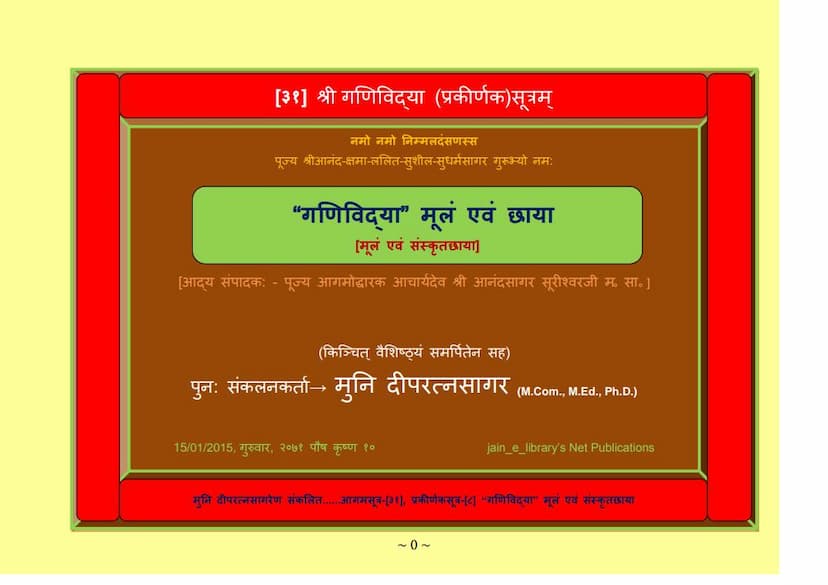Aagam 31 GANIVIDHYAA Moolam Evam Chhaayaa
Added to library: September 1, 2025

Summary
Here's a comprehensive summary of the Jain text "Aagam 31 GANIVIDHYAA Moolam evam Chhaayaa":
This Jain text, "Aagam 31 GANIVIDHYAA Moolam evam Chhaayaa," is a compilation and presentation of the Ganividhya Prakirnakasutra (Chapter 8 of the 31st Agam). The term "Ganividhya" itself can be understood as the knowledge or science related to various aspects of time, auspiciousness, and movement.
Key Information about the Publication:
- Original Work: The text is based on an older publication by the Agamoday Samiti, titled "Chatuhsharanaadi Maranasamadhyantam Prakirnakadashakam" (A Decade of Prakirnakas from Chatuhsharana to Maranasamadhi), first published in 1927 (Vikram Samvat 1983). This original work was edited and compiled by Acharya Shri Anandasagar Surishwarji Maharaj Saheb (Saganand Suriji).
- Present Compilation: The current version has been re-compiled, scanned, and presented by Muni Diperatnasagar (M.Com., M.Ed., Ph.D.). This new edition includes the original Prakirnakasutra along with its Sanskrit translation (Chhaya).
- Purpose of Re-compilation: Muni Diperatnasagar explains that his effort is driven by respect for the original work and the teachings of Acharya Saganand Suriji. He notes that subsequent publications often reproduced the original work with their own names and omitted the original editor's and publisher's credits, which he aims to rectify and preserve.
- Format and Enhancements: This edition is presented in a special format where the original scanned text is placed in the middle, with the Agam's name and verse/chapter numbers at the top. A "Deep Anukram" (Deep Index) is provided on the left for easy reference across various Agam publications. Footnotes are included to clarify printing or numbering errors found in the original.
- Digital Publication: This is presented as a Net Publication by jain_e_library.org for wider accessibility, with plans for future print publication.
Content of Ganividhya Prakirnakasutra (Chapter 8):
The "Ganividhya Prakirnakasutra" is essentially a guide to auspicious timings and practices based on various celestial and temporal factors. It is structured into several "Dwaras" (sections or gateways) dealing with different elements that influence the auspiciousness of an event or action. The core idea is to understand the strength and weakness ("Balabal") of different components to determine the best time for undertaking specific activities.
The main topics covered in the text, as indicated by the index, are:
- Divas (Days): Discusses the auspiciousness of different days, including the strength of days and nights, and the impact of lunar phases (bright and dark halves).
- Tithi (Lunar Days): Explains the significance of various lunar days (Pratipada, Dwitiya, Tritiya, etc.) and their effects on endeavors.
- Nakshatra (Lunar Mansions): Details the auspicious and inauspicious constellations for commencing journeys and other significant actions. It also describes the impact of specific planetary influences on these nakshatras.
- Karana (Half-Tithi): Covers the strength and effects of the eight Karanas (e.g., Bava, Balava, Kolava) and how they are determined, especially in relation to lunar days and their transitions.
- Grah (Planets) and Muhurta (Auspicious Times): This section likely delves into the influence of planets and specific auspicious time intervals (Muhurtas). It discusses how planets affect these time segments and suggests appropriate actions based on these planetary configurations.
- Shakun (Omens): This section focuses on omens, particularly those associated with animals (Shakuni) and other signs, and their implications for undertaken activities. It categorizes omens based on their nature (male, female, neuter) and provides guidance on when to proceed and when to abstain.
- Lagna (Ascendant): This part deals with the significance of the ascendant (Lagna) in relation to auspicious beginnings. It discusses how different Rasis (zodiac signs) and their positions influence the outcome of activities undertaken during specific times. It also emphasizes the role of favorable and unfavorable Lagnas.
- Nimitta (Signs/Portents/Indications): This is the final and concluding section, highlighting the paramount importance of Nimitta. It stresses that while other factors like days, tithis, nakshatras, and grahas have their influence, Nimitta is considered the most significant (Pradhana). The text suggests that correct interpretation of Nimitta can lead to successful outcomes, and incorrect or overlooked Nimitta can lead to the failure of otherwise well-planned endeavors.
Underlying Principles:
The "Ganividhya" emphasizes a holistic approach to timing and action, where the combined influence of celestial bodies, lunar phases, constellations, and auspicious signs are considered. The core message is about understanding the balance of power (Balabal) among these elements to make informed decisions and undertake activities at the most favorable times, leading to success and well-being. It aligns with the Jain principle of understanding cause and effect and acting in accordance with the natural order to minimize suffering and maximize positive outcomes.